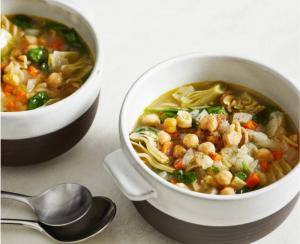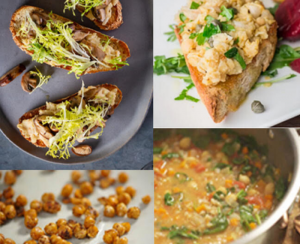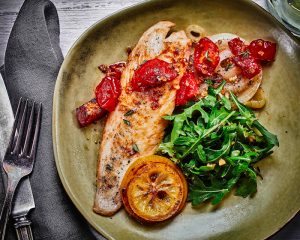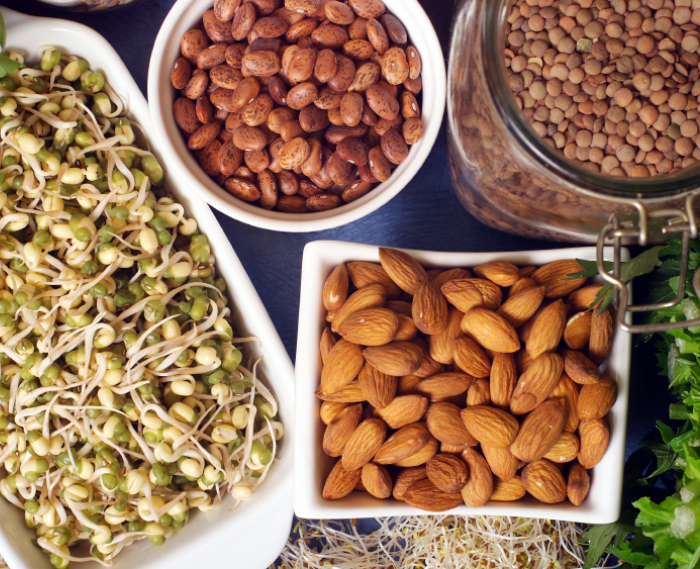If you are trying to eat less meat, you have plenty of company. Our cultural tide is flowing steadily in that direction. Just look around–there are multiple bestselling books touting the benefits of plant based eating; the Meatless Monday campaign has become mainstream, with awareness and participation climbing rapidly over the past decade; and the word “flexitarian” is now in the Merriam-Webster dictionary ( meaning “one whose normally meatless diet occasionally includes meat or fish.”).
Americans still eat about triple the global average, but meat consumption trends show we are starting to backing off. And people no longer consider beef, pork and poultry-free meals a fringe idea: 47% of those polled by the Vegetarian Resource Group said they eat at least one vegetarian meal each week, and the group reports 1 in 4 people say they are “meat reducers,” actively trying to eat less of it. It’s a trend supported by our country’s top nutrition advisory committee which, in its recent report for the Dietary Guidelines update, recommended we cut back on meat for the sake of our health and the environment.
But simply eating less meat is not a solid plan in and of itself. What you decide to pile on your plate instead of that steak, chop or cutlet is equally, if not more, important. If less meat translates to more stuffed-crust pizza or boxed mac and cheese for dinner, you are could be doing yourself more harm than good.
Even those committed to healthy vegetarian options often don’t strike the right balance. Many turn to dairy, particularly cheese, as their default protein, which can certainly make for nutrient-packed and delicious meals. But if you are eating meatlessly a lot, and dairy is your only go-to, you could be missing out on some important nutrients and getting more unhealthy fat than you realize.
Meat is more than just protein– it is incredibly rich in several essential minerals and vitamins, particularly B vitamins, zinc, iron and selenium. While dairy packs many B vitamins, selenium, and other nutrients in spades, it doesn’t have zinc, iron, or much B6. And while options like low-fat yogurt and milk are lean, a piece of cheddar cheese the size of your thumb has about double the saturated fat of 3-ounces of lean beef.
Lemony Chickpea Stew with Pasta and Artichokes

To eat healthfully with less meat, it’s important to include more plant protein: nuts, seeds, beans, lentils, peas and whole grains. While these are incomplete proteins, lacking the full spectrum of essential amino acids in sufficient amounts on their own, the amino acids in grains complement those in the nuts and legumes, so together they are complete. You don’t have to eat them at the same time, as was once thought. Just getting a variety throughout the day will help cover you, not only for the protein you’d otherwise be getting from meat, but for iron, zinc, and B6 as well. Plus, they contain healthy fats, fiber and a spectrum of protective antioxidants.
Enjoying them is as easy as opening a can of chick-peas to sprinkle on your salad, tossing some frozen shelled edamame and/or almonds into a vegetable stir-fry to serve over brown rice, slapping together a peanut butter sandwich on whole grain bread, or making or buying some lentil soup or a container of hummus.
Surprising Ways to Use Canned Beans

And thanks to the meatless trend’s popularity there are more plant protein options than ever in restaurants and fast casual spots, from bean burritos to salads with topping options like quinoa and sunflower seeds.
It would also be a step in the right direction if eating less meat got you hooked on more seafood. The average American gets less than half the recommended 8-ounces a week, an amount that studies show can reduce your risk of dying of a heart attack by about a third. That benefit is mostly due to its protective omega 3 fats, but seafood is a total package with high quality protein, many of the minerals and vitamins that meat has, and then some. So toss some shrimp or a salmon fillet on the grill, flake some tuna on your salad, or toss some chopped sardines into your pasta.
5 Reasons Every “Body” Loves Fish

Eggs can also be a stellar way to get some of the protein and nutrients meat would dish out. For just 140 calories two large eggs gives you 8% of the daily value for zinc, iron and B6, plus choline, vitamin D and many other nutrients. It is worth keeping in mind though that two eggs has about the same amount of saturated fat as a 3-ounces of T-bone steak. Nonetheless, eggs are so easy and economical it’s not surprising they are the latest darling of the culinary world. Add an egg to just about anything from a salad to a rice pilaf and it becomes a main course. If you need inspiration just search #PutanEggonIt on Instagram and your will find 21,000 entries.
Whatever protein you choose, the bottom line is don’t blindly take the meat off your plate, instead think about the quality and variety of what to fill it with.



